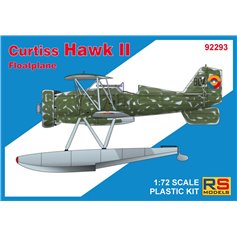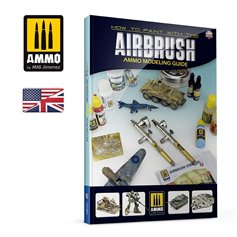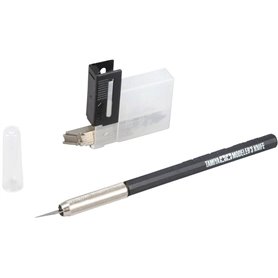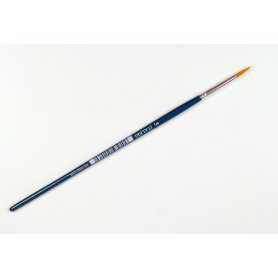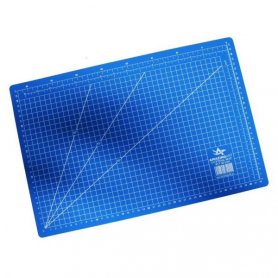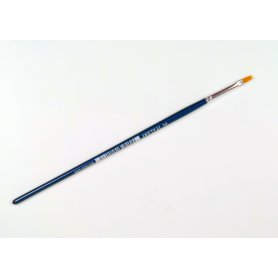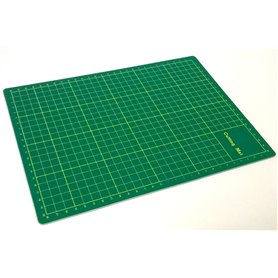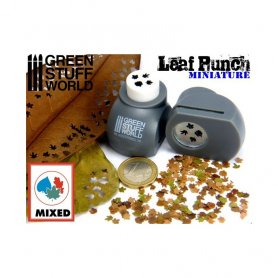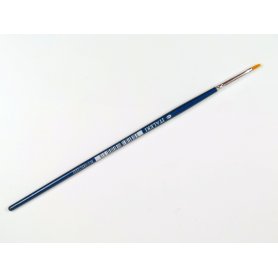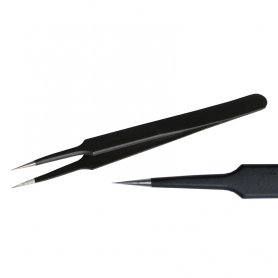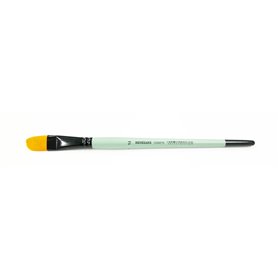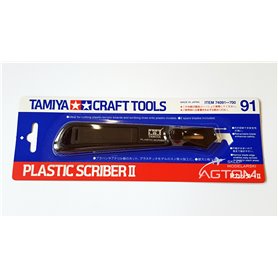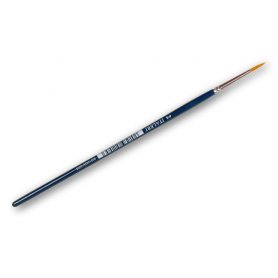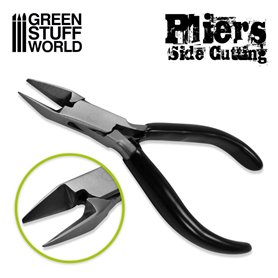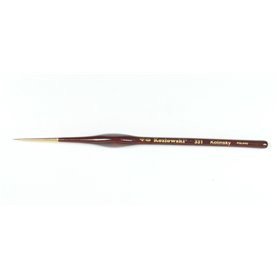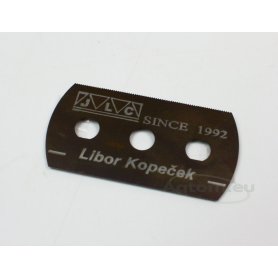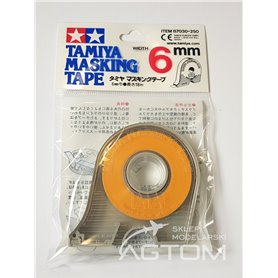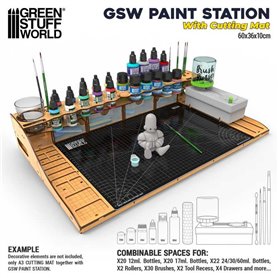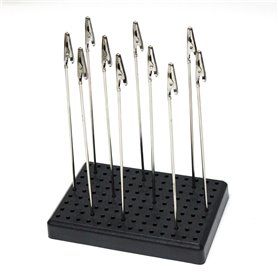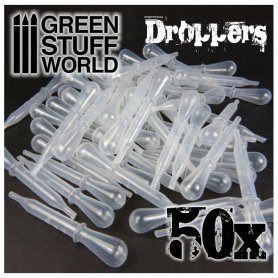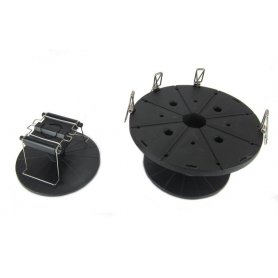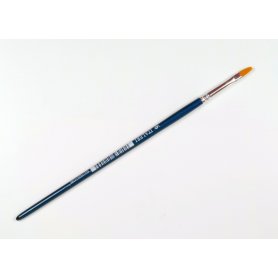Brushes
Choosing the right painting tools allows you to professionally finish large or small structures. In our online store you will find various modeling brushes. They are ideal for applying acrylic or oil paints, creating precise patterns and painting larger surfaces. Thanks to their solid construction - a durable, ergonomic handle and high-quality bristles - they will meet the requirements of all users. We encourage you to view the entire category. We provide a large selection of useful accessories.
Excellent modeling brushes
Artistic or construction works can have many faces, so purchasing the right products plays a key role. Carrying out painting tasks is much easier with modeling brushes, which are available in our store. We offer a variety of products at attractive prices. We recommend models with natural or synthetic bristles (including silicone). Depending on your needs, you can choose flat, round or beveled variants. It is worth ordering individual items and sets now.
Cutting tools
Sanders and sandpaper
Tweezers
Workshop equipment
Cutting matts
Masking tapes
Masking Tapes – A Precise and Essential Tool for Modelers
Masking Tapes are an indispensable accessory in the world of modeling, which allows for precise separation of fragments painted in different colors. They are crucial when we want to obtain clean, even lines, as well as precise transitions between paint colors. Thanks to their use, you can create professional-looking models, without the risk of destroying your work during painting and peeling off the tape.
Types of Masking Tapes
Depending on the type of surface and the degree of complexity of the model being painted, we distinguish two basic types of Masking Tapes:
- Flexible Masking Tapes – Designed for painting elements of irregular shapes. Thanks to their flexibility, they can be easily arranged in arcs, making them an ideal tool for more advanced modeling projects.
- Regular masking tapes - Designed for masking flat surfaces. They provide precise and even lines, ideal for simple, geometric shapes.
Masking tapes are designed in such a way that they do not remove previously applied paint, provided that the paint is completely dry and the primer has been applied correctly. They do not leave any traces of glue, which is important for maintaining the aesthetics of the finished model.

Advantages of using masking tapes in modeling
- Precise color cutting – Masking tapes allow for precise separation of surfaces painted with different paints, which is crucial for achieving professional effects.
- Easy to remove – After painting, the tapes can be easily removed without the risk of damaging the previously applied paint.
- Possibility of multiple use – In some cases, cut pieces of tape can be reused. It is worth remembering, however, that after the first use the strength of the adhesive may be weakened, which can be used when we want to achieve a more delicate gluing effect.
Types of products in the category Masking tapes
In our offer you will find various types of masking tapes, adapted to the needs of every modeler:
- Paper tapes - Ideal for precise masking of straight lines. Easy to cut with a knife, they provide accurate and even color cutting on flat surfaces. Paper tapes usually come in yellow
- Elastic tapes - Made of plastic (white) or elastic non-woven fabric (blue), they allow for arching and masking of elements with irregular shapes. Often used in more intricate projects where smooth lines and precise curves are required.
- Masking sheets – Self-adhesive sheets of paper for masking large surfaces. Great for covering larger areas of a model that do not require painting.
How to use masking tape?
Using masking tape is simple, but it is worth remembering a few rules:
- Before applying the tape, make sure the paint on the model is completely dry to avoid damaging it when removing the tape.
- For a more subtle gluing effect, apply the tape to another surface (e.g. a table) first, and then to the model.
- Once you have finished painting, remove the tape carefully, at an angle, to get a straight line.
Drills and drill bits
Drill Bits
Drill bits are one of the fundamental tools in every modeler's workshop. Their role isn't limited to just making holes. They are precision accessories that allow for modifying parts, adding details like gun barrels, antennas, or rigging, and preparing components for reinforcement with metal pins. Choosing the correct drill bit diameter is crucial for achieving a realistic and clean effect without damaging the delicate parts of the model.
What Modeling Drill Bits to Choose?
The primary tool is a hand drill, often called a "pin vise," which provides maximum control over the drilling process and minimizes the risk of damaging plastic. It is used with sets of drill bits in various diameters, most commonly ranging from 0.3 mm to about 3 mm. For more advanced work or for handling harder materials like resin or white metal, electric mini drills can be useful. However, they require more skill, as their high rotational speed can easily melt plastic. It's best to choose drill bits made from high-speed steel (HSS), which are known for their durability and sharpness.Applications of Drill Bits in Modeling
Modeling drill bits are used for many tasks. They can be used to drill out the barrels of cannons and guns on aircraft or armored vehicle models, which significantly enhances their realism. They are essential for creating mounting holes for antennas, masts, rigging lines on ship models, or railings. They are also used to prepare parts for "pinning"—joining components with pieces of metal wire—which ensures a sturdy construction, especially for resin models. Whether you are working with plastic, resin, wood, or photo-etched parts, you will find the right drill bit for your project in this category. Modeling Power Tools
What Are Power Tools for Modeling?
Power tools for modeling are an essential part of any advanced modeler's workshop. While many tasks can be accomplished with hand tools, using their electric counterparts significantly speeds up the process, enhances precision, and enables you to work with harder materials like metal and dense plastics. Our selection features tools specifically designed for model making—characterized by their compact size, low weight, and precise speed control, which is crucial for handling delicate details. With these tools, tasks such as drilling miniature holes, grinding weld seams on tank models, or cutting structural components become easier and deliver superior final results.
Types and Uses of Power Tools in Modeling
The cornerstone of this category is the rotary tool (often referred to by the brand name 'Dremel'). Thanks to a wide range of interchangeable attachments, it can function as a drill, sander, router, polisher, or mini-saw. It's an incredibly versatile tool, perfect for anyone starting with power tools. For modelers who specialize in scratch-building, specialized table saws and circular saws are invaluable for making precise, angled cuts in wood, plywood, or plastic. Our range also includes precision drill presses for creating perfectly perpendicular holes, and engravers for easily scribing details like panel lines on aircraft models.
How to Choose the Right Tools for You?
When selecting power tools, consider a few key factors. First, the power source. Most modeling tools run on low voltage (e.g., 12V) and require a dedicated power supply with speed control. Second, power and rotational speed (RPM). Lower-power tools are sufficient for delicate plastic work, while more powerful models are necessary for metal. Ergonomics are also crucial—the tool should feel comfortable in your hand. Finally, check the availability of accessories and spare parts, such as drill bits, cutting discs, and grinding stones, to ensure you can fully leverage your equipment's potential.
Holders and Clamps
Holders and Clamps – Precision and Comfort in Scale Modeling
Working on a model requires great precision and often, both hands free. Modeling holders and clamps are a category of tools designed to immobilize parts during gluing, painting, sanding, or soldering. They make the work significantly easier and more comfortable, minimizing the risk of errors, such as accidentally moving glued parts. This is essential workshop equipment that both beginners and experienced modelers will appreciate, ensuring stability and consistency in their work.
Types of Holders and Their Applications
Our offer includes various types of holding tools. A popular solution is the "helping hands" tool, equipped with adjustable arms ending in alligator clips and often a magnifying glass, ideal for precise work with small details or electronics. For gluing larger components, like fuselage halves or wings, spring clamps and other clamps are indispensable. Available in various sizes, they allow for even pressure on the surfaces being glued. Small modeling vises are an excellent choice for securing parts during mechanical processing, such as drilling or sawing. For painting details, we recommend special holders with clips that allow you to conveniently paint the entire surface without touching it.
Choosing the right tool depends on the type of work and the scale of the model. It's a good idea to equip your workshop with several different types of clamps and holders to be prepared for any challenge. Well-chosen tools are an investment that significantly enhances the quality and enjoyment of the modeling hobby.
Panel Lines and Rivets
Tools for Scribing Panel Lines and Rivets
Panel lines and rivets are crucial details that give models a realistic look, especially for aircraft, armored vehicles, or ships. Often, the factory-molded lines are too shallow or get filled in during puttying and sanding. In such situations, precise tools that allow for re-scribing or deepening them become essential. In this category, we have gathered everything you need for scribing lines and applying rivet details to make your model look like a miniature of the real machine.
Scribers, Engravers, and Scribing Templates
The primary tool for working with panel lines is a scriber, also known as an engraver. It is used to engrave new lines or deepen existing ones in the plastic. Various types of scribers are available, from simple needles in a handle to specialized blades of different widths (e.g., 0.1 mm, 0.2 mm) that create a clean, uniform groove. For precise work, it's best to use scribing templates with various shapes and flexible tapes that act as guides for the blade. Thanks to them, even complex patterns and curves will not be a problem.
Riveters, or Riveting Tools
Rivets are just as important as panel lines. Special tools called riveters are used to recreate them. These are most often rotating wheels with teeth at various spacings, which, when pressed against the model's surface, leave a realistic impression imitating a row of rivets. Choosing the appropriate tooth spacing depends on the scale and type of the model. An alternative to engraving is using ready-made rivets in the form of decals or 3D resin details, which are applied directly to the model. This is a great solution when you want raised rivets and maximum precision.
Wet Palettes
What is a Wet Palette and What Is It For?
A wet palette is one of the essential tools for anyone who paints models or miniatures with acrylic paints. Its main purpose is to prevent the paint from drying out too quickly, a common problem when working with acrylics. The palette typically consists of a flat container, a special sponge (hydro sponge), and sheets of membrane paper (hydro paper). The sponge is soaked in water, and a sheet of paper is placed on top of it. Water from the sponge gradually seeps through the membrane, keeping the paint on top consistently moist. This keeps the paint workable for many hours, or even days.
The Advantages of a Wet Palette and Our Offer
Using a wet palette significantly improves the comfort of your workflow. It allows you to freely mix colors directly on the palette without worrying about the paint drying out. It also saves you money – you won't waste paint that would otherwise become unusable after just a few minutes. It's an ideal solution for both beginners learning painting techniques and advanced modelers working on long, complex projects. In this category, you'll find everything you need to get started with a wet palette or to restock your supplies. We offer complete wet palette sets in various sizes, from compact versions perfect for travel to larger palettes for demanding users. Refills such as spare sponges and packs of specialized membrane paper are also available.
Painting Palettes
A painting palette is one of the essential tools in every modeler's workshop. It allows for convenient dispensing, mixing, and thinning of paints, which is crucial for achieving precise colors and the desired consistency. Whether you're painting plastic models, miniatures, or creating dioramas, the right palette helps keep your workspace tidy and gives you full control over the painting process. It helps you avoid wasting paint and provides a surface where you can freely combine different shades to create unique colors.
Types of Modeling Palettes
In our offer, you will find various types of palettes tailored to specific needs and painting techniques. The most popular choice among modelers are wet palettes. They consist of a special container, a sponge, and sheets of paper that, when soaked in water, keep acrylic paints moist for many hours, or even days. This is an ideal solution for techniques like blending or layering, as it prevents the paint from drying out too quickly. We also offer classic dry palettes, made of plastic or ceramic. They are simple to use and easy to clean, making them great for working with oil paints, enamels, and for quick painting projects.Which Painting Palette Should You Choose?
The choice of the right palette mainly depends on the type of paints you use and your working style. If you primarily paint with acrylics and value a comfortable, unhurried workflow, a wet palette will be indispensable. It will give you time for precise color mixing and making corrections. For those using oil or enamel paints, as well as for beginner modelers who want to start with simpler solutions, a traditional dry palette with wells will be a good choice. Regardless of your decision, a well-chosen palette is an investment that significantly enhances the quality and comfort of painting any model. Bottles, jars and pipettes
Plastic bottles and containers for storing your own paint mixtures or any other liquids.
Benders
Tools for forming brass photoetched parts
Punch tools
Tool sets
Rulers
Tools for dioramas and vegetation
Pliers
Applicators & Spatulas
Precision in Every Detail – Applicators and Spatulas
Applicators and spatulas are fundamental yet incredibly important tools in every modeler's arsenal. While they may seem simple, their correct use is crucial for the final appearance of a model. They are used for the precise application, mixing, and shaping of various materials like putties and texture pastes, as well as for applying paints, glues, and pigments. With them, you can achieve smooth surfaces, fill gaps, create textures, or apply a tiny amount of glue exactly where it's needed. Without these tools, precise detailing would be significantly more challenging.
Types and Uses of Modeling Spatulas
Our collection features applicators and spatulas made from various materials and in diverse shapes, allowing you to choose the perfect tool for any specific task. Metal spatulas, typically made of stainless steel, are highly durable. They are ideal for mixing thick putties, removing flash, or scraping. In contrast, tools made from flexible plastic are perfect for smoothing putty on large, curved surfaces without scratching the material. They are available in many shapes: flat and wide for large planes, narrow and pointed for precision work in tight corners, and rounded for shaping curved forms. Some sets even offer interchangeable tips, enhancing their versatility.
How to Choose the Right Tool?
Choosing the right spatula depends on several factors. First, consider the type of material you will be working with. For dense, two-part putties, durable metal spatulas are the best option. For applying thin paints or pigments, delicate applicators or microbrushes are sufficient. The scale of your model is also a key factor – the smaller the subject, the more precise and smaller the tools required. It is wise to invest in a basic set of various spatulas, which will provide the flexibility needed for different projects. Proper maintenance, which involves cleaning your tools regularly after each use, will ensure they last for a long time.
Pipettes
The Use of Pipettes in Scale Modeling
Pipettes are among the most basic and incredibly useful tools in any modeler's workshop. Their primary function is to precisely measure and transfer small amounts of liquids such as paints, thinners, glues, or liquid pigments. They help prevent spills of valuable materials and reduce waste. Working with a pipette ensures cleanliness and accuracy, which is crucial for complex projects. They allow you to draw up the exact amount of liquid needed—a task difficult to achieve when pouring directly from the bottle.
How Do Modeling Pipettes Make Your Work Easier?
Using pipettes significantly simplifies many modeling tasks. They are indispensable for mixing paints to create custom colors, allowing for the precise, drop-by-drop addition of individual pigments. They are also a key tool when preparing mixtures for an airbrush, where the correct paint-to-thinner ratio determines the final finish. Pipettes are also excellent for applying liquid glues, washes, filters, and other weathering products, enabling you to place them exactly where needed without the risk of flooding the model's details.
Our selection includes various types of pipettes, most commonly made of plastic (disposable Pasteur pipettes) with different capacities, such as 1 ml, 3 ml, or 5 ml. This allows you to choose the right tool for the scale of your project and the specific task at hand. Whether you are a beginner or an advanced modeler, pipettes are an accessory that should be in your essential toolkit.
Modeling Cotton Swabs
Professional Modeling Cotton Swabs
Cotton swabs, also known as modeling applicators, are a fundamental and incredibly versatile tool in every modeler's workshop. Unlike standard cosmetic swabs, modeling versions feature tightly-wound, high-quality cotton that does not leave lint on the work surface. This is crucial when working with paints, varnishes, or delicate decals. The firm, stiff handles, most often made of wood, paper, or plastic, ensure a secure grip and allow for precise operation even in hard-to-reach areas of the model. In this category, we offer a wide selection of swabs with various tip shapes—from classic round and pointed tips to flat and triangular ones, allowing you to choose the perfect tool for any specific task.
The applications for cotton swabs are virtually limitless. They are indispensable for applying waterslide decals, where they are used to gently press them down, remove excess water, and eliminate air bubbles. In weathering techniques, they are used for rubbing in dry pigments, smudging streak effects from washes, or blending oil paints to achieve subtle tonal transitions. They are also an excellent tool for precision cleaning—allowing you to remove excess glue, wipe away misplaced paint, or collect dust from delicate details before painting. Whether you are building aircraft, armored vehicles, or figurines, professional-grade cotton swabs will significantly enhance the comfort and quality of your work.
Sculpting Tools
Essential Tools for Model Sculpting
Sculpting tools are essential for any modeler who wants to go beyond simply assembling pre-made parts. They allow you to create custom details, modify factory parts, and even sculpt entire figures or diorama elements from scratch. They are indispensable for working with popular modeling compounds like Green Stuff, Milliput, Aves Apoxie Sculpt, as well as traditional polymer clays. High-quality tools provide precision and control over the material, which directly impacts the final look of the model. They enable you to add textures, smooth surfaces, and create intricate shapes that would be impossible to achieve with bare hands.
Types of Sculpting Tools and Their Uses
Our offer includes a variety of tools, each with its specific purpose. The core of the range consists of metal spatulas and chisels with various tips (flat, rounded, pointed), used for applying, shaping, and texturing modeling putties. For precise cutting, removing flash, and carving harder details, sharp scalpels and hobby knives are essential. For creating the finest details, such as fabric texture, hair, or eyes, engraving needles are indispensable. Tools with flexible silicone tips are also gaining popularity, ideal for gently smoothing and blending surfaces without leaving marks.
How to Choose the Right Tools for You?
The choice of tools depends on the type of work you do and your skill level. For beginners, a basic set of a few tools with different shapes is often enough to get familiar with sculpting techniques. It's worth paying attention to the material – stainless steel tools are durable and easy to clean. A comfortable, ergonomic handle also matters, especially during long work sessions. Regardless of your choice, keeping your tools clean is crucial to ensure their longevity and precision for years to come.
Silicone Molds
The Use of Silicone Molds in Scale Modeling
Silicone molds are flexible tools used for creating precise casts and replicating details. In scale modeling, they allow you to produce your own repetitive elements, such as weaponry parts, wheels, bricks, paving slabs, or other architectural details. With them, you can easily duplicate an existing element or create a completely new, custom part for your model or diorama. Molds made of silicone are highly flexible and durable, which makes it easy to demold the finished casts without the risk of damage. They can be used with various materials, most commonly polyurethane and epoxy resins, modeling plaster, or polymer clays.
Creating Your Own Parts and Details for Dioramas
Ready-to-use silicone molds are an excellent solution for modelers looking to enrich their projects with unique details. Instead of hand-sculpting every stone, crate, or wall fragment, you can use a mold to quickly produce many identical, detailed objects. This is especially useful when building dioramas that require a large number of repetitive scenic elements, like sandbags, barrels, or cobblestones. The molds also allow for the replication of hard-to-find or damaged parts for vehicle, aircraft, or ship models. This makes the customization and repair process much simpler and yields more professional results.
Using silicone molds is straightforward and requires no specialized equipment, making them accessible even to beginner hobbyists. Simply prepare the appropriate casting material (like resin or plaster), pour it into the mold, and wait for it to cure. The flexibility of the silicone makes it easy to remove the finished part, and the mold is immediately ready for reuse. It's an economical and effective tool that opens up new creative possibilities for modelers, allowing them to achieve a high level of realism in their projects.
Hammers
Although a hammer is mainly associated with construction work, in model making, it's a tool that requires precision and a delicate touch. Modeling hammers are used for delicate tasks such as shaping small metal parts, driving pins and rivets, or fitting components without damaging them. Unlike their larger counterparts, they are characterized by their light weight, a precisely shaped head, and an ergonomic handle, which ensures full control over every strike. They are essential in the workshop of any modeler who works with photo-etched parts, sheet metal, or wire constructions.
Types of Hammers in Model Making
Our selection includes various types of hammers, tailored for specific tasks. Ball-peen hammers are ideal for shaping and rounding sheet metal. Hammers with interchangeable tips made of brass, nylon, or plastic allow for striking delicate surfaces without the risk of scratching or denting them. They are often used when assembling fragile resin or plastic parts. It's also worth noting small dead-blow hammers, whose design minimizes rebound from the struck surface, increasing precision when working with small components.How to Choose the Right Modeling Hammer?
When choosing a hammer, you should pay attention to several key features. First and foremost is the weight – the lighter the model, the greater the control over the impact force. The material of the head is also important. Steel heads are versatile, but for working with soft metals or plastic, brass, aluminum, or nylon tips are better suited. An ergonomic, well-balanced handle provides comfort even during prolonged use and prevents hand fatigue. A well-chosen hammer is an investment that significantly simplifies your work and improves the quality of the finished model. Paint Mixing Balls
Paint mixing balls, also known as agitators, are a simple yet incredibly effective accessory in every modeler's workshop. Model paints, especially acrylics, have a tendency to separate during storage. Heavier pigments settle at the bottom, leaving the binder medium at the top. Manually shaking the bottle is often not enough to achieve a uniform mixture again, leading to coverage issues and streaking. A ball dropped inside acts as a mixing aid – when shaken, it strikes the bottom and sides of the container, effectively breaking up clumped pigment and ensuring a perfectly smooth paint consistency. This makes painting easier and the final result significantly better.
How to Choose and Use Paint Mixing Balls?
Using the balls is very simple – just drop one or two into a paint pot or bottle and shake vigorously. The market offers balls made from various materials, most commonly stainless steel or glass. Steel balls are heavier, making them very effective at breaking up sediment. It's important to ensure they are made of rust-resistant steel that won't contaminate the paint. Glass balls are chemically inert and a safe alternative for any type of paint. Agitators are reusable. After the paint is used up, they can be easily cleaned and transferred to a new container.An Essential Addition to the Modeler's Workshop
Investing in mixing balls is a small expense that significantly improves the comfort of work and the quality of your paint job. This tool is useful not only for new paints but is also indispensable when reviving older, long-unused colors. Instead of struggling with separated paint, a few shakes are all it takes to restore its full properties. Our offer includes balls of various diameters, suited for popular model paint containers. Other tools




